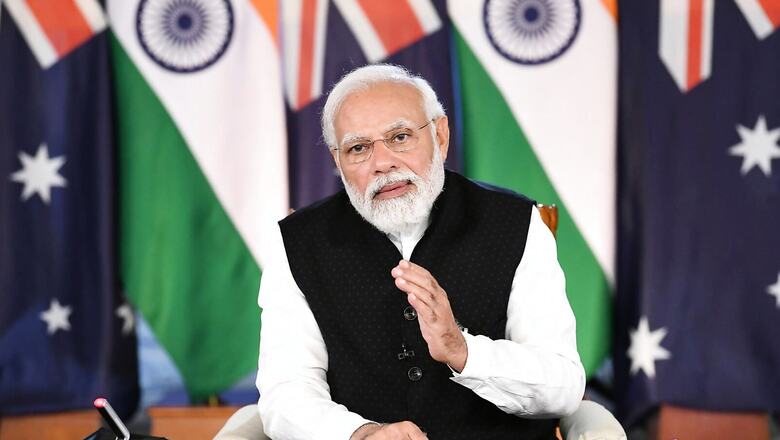
views
The new trade deal between India and Australia has come as a “shockwave” to those of us involved in the relationship. For over 20 years, I have seen the trade and investment relationship of the two countries just cruise along, without urgency or intent. Even the idea of finding a small deal around some “early harvest” agreements signalled more of the same – slow, lacking urgency. Now all that has changed.
The Australia-India Economic Cooperation and Trade Agreement, signed on April 2, will turbo charge trade between the two countries and could see India-Australia trade over A$75 billion within five years.
It comes on top of India and Australia really getting to know and understand each other like never before as they participated in the invigorated Quad group with Japan and USA. Business and education leaders from both countries should be booking their flights as soon as possible. The scale of this new deal is opening doors like never before.
ALSO READ | India’s Message to Australia is Clear: New Delhi Prefers Deals with Countries, Not Groups
Virtually nobody expected the scale of this deal – tariffs will be eliminated on more than 85% of Australian goods exported to India, which will rise to about 91% over 10 years. While 97% of Indian goods will immediately gain preferential access to Australia. The size of the deal should become an urgent action point for board rooms around both countries.
A whopping 96 per cent of Indian goods imports will now enter Australia duty-free. This has got to provide a boost for labour-intensive sectors in India. Among the surprises is the deal to liberalise visa norms for students and professionals, including quota for Indian chefs and yoga teachers.
India and Australia can set new goals and new approaches in education – we should “reimagine” the India-Australia education relationship, making it more collaborative and more two-way. Australia has much to gain and should set its sights on becoming the number one choice for Indian students.
Extensions of work visas to two and four years for Indian students will lead to a sharp increase in demand – perhaps more than Australian educators anticipate.
The experience of the Australia India Institute in Melbourne can provide a valuable guide and play a leading role in this reimagining of our education and research relationship.
Australian Prime Minister Scott Morrison and Indian Prime Minister Narendra Modi have put in the hard work to build this partnership – especially through the Quad plus a $280 million investment programme, and other regional and personal meetings.
So, too, have Australian Trade Minister Daniel Tehan and Indian Commerce Minister Piyush Goyal, who is a regular and popular visitor to Australia. Both ministers will be in Melbourne this week for a range of meetings, including a private business lunch hosted by the Australia India Chamber of Commerce.
I would like to see both governments set targets much higher – they want a doubling of trade in five years to A$50 billion. This is a conservative estimate which does not take into full account the new appetite for business and education connections.
After the Australian FTA with China, few predicted the massive growth to $235 billion, leapfrogging China into clear leader among our trading partners. The same rate of growth could happen to India if business and government grasp the opportunities of this new deal.
Of course, somewhere in the background of this new closer relationship of Australia and India is China, but it also reflects a changing view of India from “down under” in Australia. The message is getting through that modern India is now an economic power, and fast becoming a regional security power.
The economic case is clear – India is by far the fastest growing major economy in the world – with GDP projected to grow at 9% in 2021-22 and 2022-23 and 7.1% in 2023-24.
Business and political leaders have realised that two-way trade of $24 billion and goods and services at $17 billion is just not good enough. The Australian government previously set a goal to lift India into our top three export markets by 2035 – this should urgently be revised and brought forward to 2030 or even earlier.
I am also keen to see investment between the two countries becoming a bigger priority – investment is a part of the trade story and India could become the third largest destination in Asia for outward Australian investment.
We can do more in other areas of our relationship. For example, there are many thousands of Indians who have graduated in Australia and returned home to India – we can both do more to engage this group and activate it to support trade and investment.
Plus, the Indian diaspora in Australia numbers approximately 700,000, and Indians are expected to outnumber Chinese-born Australians over the next decade. Significantly, it is the second-highest taxpaying diaspora after the British, making it clear that it is a group making significant contributions to Australia’s economy. It can contribute more to building the cross border relationships we need.
Both governments have demonstrated that trade is about people-to-people relationships. Over to you, the business and education leaders of both countries. Time to break records!
Stephen Manallack is blogger at INTO INDIA, Director of EastWest Advisors and former President of Australia India Business Council. The views expressed in the article are those of the author and do not represent the stand of this publication.
Read all the Latest Opinion News and Breaking News here
















Comments
0 comment